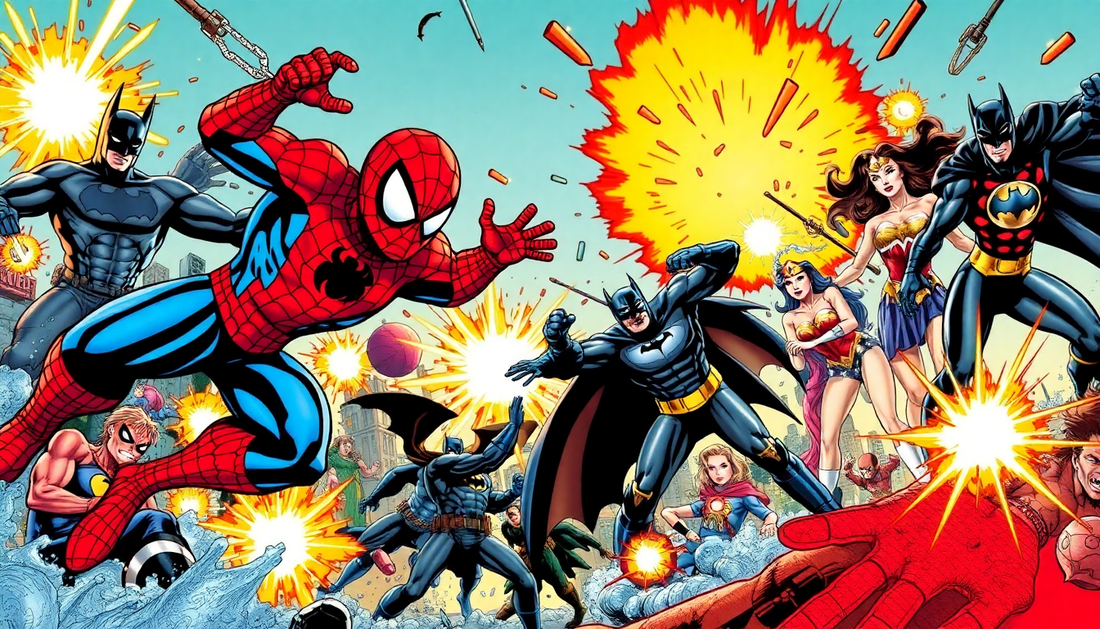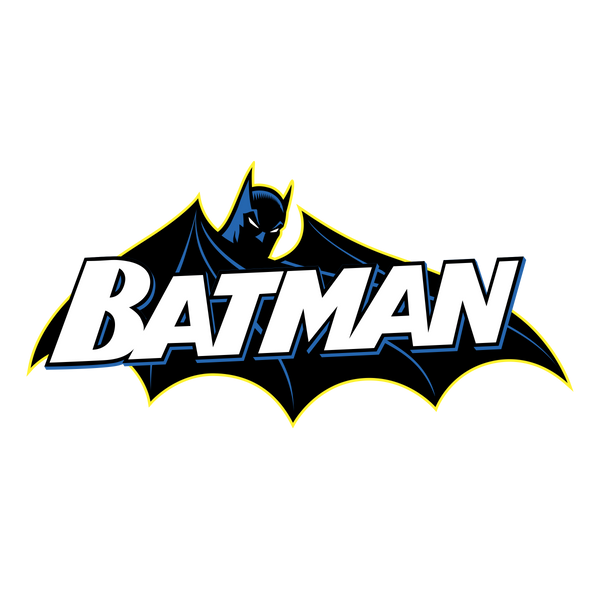
Marvel vs DC Comics: Battle of the Giants
Marvel vs. DC: Two Visions of the Superhero
For over 80 years, Marvel and DC Comics have battled to dominate the collective imagination around superheroes. These two giants have built rich universes, populated by iconic figures who have fascinated entire generations. On one side, Marvel and its fallible, everyday characters. On the other, DC, with its almost god-like heroes, like Batman, the Dark Knight, the very embodiment of brutal, tortured justice. Beyond the costumes and powers, these are two opposing philosophies, and that's what makes their comparison so fascinating.
The Marvel Universe: Humans at the Heart of the Myth
Marvel, officially founded in 1961, has always emphasized proximity. Its heroes live in New York, suffer, doubt, love. Spider-Man , a penniless teenager, juggles superhero responsibilities with his personal life. Iron Man confronts his inner demons, between alcoholism and guilt. The Hulk is a living metaphor for repressed anger. They are superhumans, certainly, but profoundly human.
- Geographic proximity: Marvel anchors its stories in real cities, making identification immediate.
- Psychological flaws: heroes are not invincible, they doubt, fail, evolve.
- Accessible tone: Humor, even in dark moments, creates a unique alchemy, especially in the MCU films.
With the launch of the Marvel Cinematic Universe in 2008 with Iron Man , Marvel revolutionized contemporary cinema. Some fifteen years later, the saga has conquered cinemas with global hits like Avengers: Endgame , becoming an interconnected narrative model. In comparison, DC has opted for a more fragmented, but often deeper, approach…
The DC Universe: Myth and Legend
DC Comics, founded in 1934, draws more inspiration from great mythological figures. Superman embodies hope. Wonder Woman symbolizes justice. And Batman crystallizes vengeance, trauma, and resilience. In this universe, Gotham City is an urban purgatory, and the Dark Knight imposes his law there, without ever crossing the red line. As our article Why Batman Doesn't Kill explains, this fundamental principle makes him a unique vigilante.
- Strong symbolism: heroes embody universal ideas (hope, justice, fear, redemption, etc.)
- Darker Atmosphere: DC stories explore duality, moral dilemmas, loneliness.
- Notable works: films like The Dark Knight , Joker or The Batman have marked the history of the 7th art.
If Marvel makes us smile, DC makes us think. The stories are often introspective, almost philosophical. The hero is often alone, confronted with his own darkness. This is particularly true with Batman, whose psychological depth appeals to comic book fans and film noir enthusiasts alike.
🦇 To embody this myth, discover our ultra-realistic Batman costumes , or show your passion every day with our official Batman t-shirts . And to explore all the Dark Knight's masterpieces, don't miss our special page on the Batman movies .
Cinematic Pillars: MCU vs DCEU
It's impossible to compare Marvel and DC without mentioning their film adaptations. Since the 2000s, the two companies have also been competing for the big screen, with radically different visions.
The Marvel Cinematic Universe (MCU): a well-oiled machine
The MCU began in 2008 with Iron Man . Under the leadership of Kevin Feige, Marvel Studios has patiently built an interconnected universe over more than 20 films, divided into phases. The culmination? The Infinity Saga, with Avengers: Infinity War and Endgame .
- Narrative continuity: each film is conceived as a piece of a coherent puzzle, where characters intersect and plots intertwine.
- Your general audience: the mix of action, humor and endearing characters makes the formula accessible to all ages.
- Commercial success: Marvel broke all box office records, gathering a huge community of fans.
But some criticize the MCU for its overly calibrated formula and its sometimes subdued stakes. That said, films like Black Panther and Spider-Man: No Way Home have made a lasting impression.
The DC Extended Universe (DCEU): A More Mature Approach
DC launched its shared universe with Man of Steel in 2013, followed by Batman v Superman and Justice League . Unlike Marvel, DC chose to dive straight into a darker, more serious atmosphere, with tortured heroes.
- Your Adult: DC movies explore deep moral dilemmas, loneliness, responsibility, redemption.
- Directors with strong identities: Zack Snyder, Patty Jenkins and Matt Reeves have each given a unique visual style to their works.
- Iconic heroes: Superman, Wonder Woman, and of course Batman, are treated like living legends.
Although the DCEU has had its ups and downs, it has delivered several gems: Wonder Woman (2017), Aquaman (2018), and especially the highly acclaimed The Batman (2022) starring Robert Pattinson, praised for its intense neo-noir atmosphere.
🦇 If you want to recreate the dark atmosphere of Gotham, explore our collection of Batman lamps and illuminate your room with the shadow of the Dark Knight. Or opt for total immersion with a Batman mask faithful to your favorite movie .
Unlike a harmonized shared universe like Marvel's, DC embraces its differences in tone and style. Some see this as a weakness, others as a strength. The two approaches coexist, and that's what makes the rivalry compelling.
Very different heroes: human versus mythical
Perhaps the biggest difference between Marvel and DC lies in the very conception of their superheroes. Marvel characters are often ordinary individuals to whom something extraordinary happens. DC heroes, on the other hand, are more like modern deities, bearers of symbols and ideals.
At Marvel: heroes with human flaws
Peter Parker is a shy teenager, Tony Stark a billionaire consumed by his inner demons, Wanda Maximoff a woman shattered by loss. These heroes are close to us; they suffer, doubt, and fail. It's these vulnerabilities that make them so endearing.
- Spider-Man struggles with his schoolwork, relationships, and lack of money.
- Iron Man confronts his ego, his past as an arms dealer and his addiction.
- The X-Men are outcasts, rejected by society for who they are.
At DC: powerful and timeless icons
DC prefers guardian figures: Superman represents hope, Batman justice, Wonder Woman truth. These are almost unattainable heroes, but their stories question universal notions. Their stories are less focused on everyday worries and more on greatness, sacrifice, and destiny.
- Batman operates in the shadows, but embodies an unwavering moral rigor.
- Superman is the archetypal savior, torn between two worlds.
- Wonder Woman is the enlightened warrior, capable of love as much as power.
These heroes have inspired a huge amount of merchandise. If you want to pay homage to this mythical dimension, explore our collection of Batman figurines or complete your universe with a Gotham-colored duvet cover .
Marvel brings you closer to heroes who could be your neighbors. DC elevates you to powerful, almost godlike archetypes. To each their own style, to each their own mirror.
Marvel vs. DC: A Rivalry That Moves the Superhero Universe Forward
The rivalry between Marvel and DC has always fueled innovation in both comics and film. This artistic duel has given rise to masterpieces, unforgettable characters, and stories that have influenced entire generations.
In cinema, Marvel has taken a lead thanks to its connected universe. But DC has often shone through the power of its standalone stories. Think of Joker , The Batman , or even Nolan's trilogy. Two opposing approaches, but both fascinating.
Fan debates are often heated, but this competition remains healthy: it pushes each house to surpass itself. And to better understand this historic opposition, don't miss our full article on Spider-Man and Batman: The Two Faces of Justice , which deciphers in depth the opposing philosophies of these two icons.
